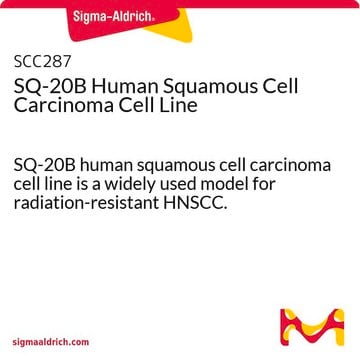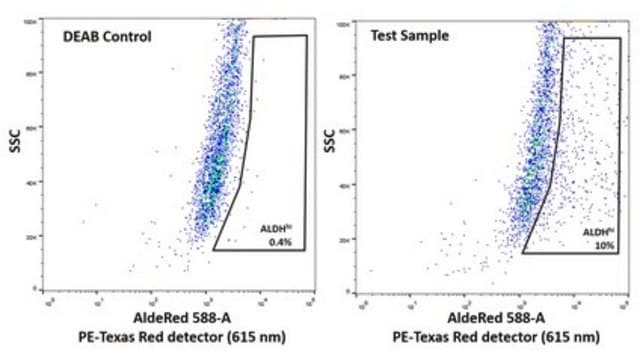推薦產品
product name
UM-SCC-1 Squamous Carcinoma Cell Line, UM-SCC-1 is a unique human head and neck squamous cell carcinoma (HNSCC) cell line isolated from a tumor located on the floor of the mouth of a male patient and is a suitable in vitro model of H&N carcinoma studies.
生物源
human
品質等級
技術
cell culture | mammalian: suitable
運輸包裝
liquid nitrogen
一般說明
All UM-SCC cell lines were derived in the lab of Dr. Thomas Carey at the University of Michigan and are exclusively distributed by Merck KGaA, Darmstadt, Germany. Access to UM-SCC cells is limited solely to those officers, employees and students of PURCHASER’s institution who need access to perform research. PURCHASER may not distribute UM-SCC cells or derivatives to third parties. PURCHASER shall comply with all applicable laws in its use and handling of the Product and shall keep it under reasonable safe and secure conditions to prevent unauthorized use or access.
THIS PRODUCT IS ONLY AVAILABLE FOR SALE TO ACADEMIC INSTITUTIONS OR NOT-FOR-PROFIT ENTITIES FOR USE UNDER THIS LIMITED USE LABEL LICENSE. FOR INFORMATION ON COMMERCIAL LICENSING OF UM-SCC CELLS, INCLUDING LICENSING TO COMMERCIAL ENTITIES, PLEASE CONTACT: licensing@emdmillipore.com
Head and neck squamous cell carcinoma (HNSCC) develops from the mucosal linings of the upper aerodigestive tract, comprising 1) the nasal cavity and paranasal sinuses, 2) the nasopharynx, 3) the hypopharynx, larynx, and trachea, and 4) the oral cavity and oropharynx. Squamous cell carcinoma (SCC) is the most frequent malignant tumor of the head and neck region. HNSCC is the sixth leading cancer by incidence worldwide. There are 500,000 new cases a year worldwide and two thirds occur in industrialized nations. It is caused by tobacco and alcohol consumption and infection with high-risk types of human papillomavirus (HPV). SCC often develops from preexisting dysplastic lesions. The five-year survival rate of patients with HNSCC is about 40-50%.
UM-SCC-1 is a unique head and neck squamous carcinoma cell line isolated from the tumor located on the floor of the mouth of a male patient. The cell line is negative for HPV-16 and for HLA-A2, a class I molecule of the major histocompatibility complex (MHC). The UM-SCC-1 cell line is 50% more invasive in vitro and displays a greater propensity for perineural and lymphatic invasion in vivo.
UM-SCC-1 was established at the University of Michigan (1) with written informed consent obtained from the patient and with the approval of the study by the Medical School Institutional Review Board.
Reference:
1) Carey, T., et al. (2012) Genotyping of 73 UM-SCC head and neck squamous cell carcinoma cell lines. Head Neck. 2010 April; 32(4): 417–426.
THIS PRODUCT IS ONLY AVAILABLE FOR SALE TO ACADEMIC INSTITUTIONS OR NOT-FOR-PROFIT ENTITIES FOR USE UNDER THIS LIMITED USE LABEL LICENSE. FOR INFORMATION ON COMMERCIAL LICENSING OF UM-SCC CELLS, INCLUDING LICENSING TO COMMERCIAL ENTITIES, PLEASE CONTACT: licensing@emdmillipore.com
Head and neck squamous cell carcinoma (HNSCC) develops from the mucosal linings of the upper aerodigestive tract, comprising 1) the nasal cavity and paranasal sinuses, 2) the nasopharynx, 3) the hypopharynx, larynx, and trachea, and 4) the oral cavity and oropharynx. Squamous cell carcinoma (SCC) is the most frequent malignant tumor of the head and neck region. HNSCC is the sixth leading cancer by incidence worldwide. There are 500,000 new cases a year worldwide and two thirds occur in industrialized nations. It is caused by tobacco and alcohol consumption and infection with high-risk types of human papillomavirus (HPV). SCC often develops from preexisting dysplastic lesions. The five-year survival rate of patients with HNSCC is about 40-50%.
UM-SCC-1 is a unique head and neck squamous carcinoma cell line isolated from the tumor located on the floor of the mouth of a male patient. The cell line is negative for HPV-16 and for HLA-A2, a class I molecule of the major histocompatibility complex (MHC). The UM-SCC-1 cell line is 50% more invasive in vitro and displays a greater propensity for perineural and lymphatic invasion in vivo.
UM-SCC-1 was established at the University of Michigan (1) with written informed consent obtained from the patient and with the approval of the study by the Medical School Institutional Review Board.
Reference:
1) Carey, T., et al. (2012) Genotyping of 73 UM-SCC head and neck squamous cell carcinoma cell lines. Head Neck. 2010 April; 32(4): 417–426.
成分
1) ≥1X106 viable UM-SCC-1 Squamous Carcinoma Cells: (Catalog No. SCC070). Store in liquid nitrogen.
品質
• Each vial contains ≥ 1X106 viable cells.
• Cells are tested by PCR and are negative for HPV-16, HPV-18, Hepatitis A, B, C and HIV-1 & 2 viruses.
• Cells are negatrive for mycoplasma contamination.
• Each lot of cells are genotyped by STR analysis to verify the unique identity of the cell line.
• Cells are tested by PCR and are negative for HPV-16, HPV-18, Hepatitis A, B, C and HIV-1 & 2 viruses.
• Cells are negatrive for mycoplasma contamination.
• Each lot of cells are genotyped by STR analysis to verify the unique identity of the cell line.
儲存和穩定性
UM-SCC-1 cells should be stored in liquid nitrogen. The cells can be cultured for at least 10 passages after initial thawing without significantly affecting the cell marker expression and functionality.
免責聲明
RESEARCH USE ONLY. This product is regulated in France when intended to be used for scientific purposes, including for import and export activities (Article L 1211-1 paragraph 2 of the Public Health Code). The purchaser (i.e. enduser) is required to obtain an import authorization from the France Ministry of Research referred in the Article L1245-5-1 II. of Public Health Code. By ordering this product, you are confirming that you have obtained the proper import authorization.
儲存類別代碼
10 - Combustible liquids
水污染物質分類(WGK)
WGK 1
閃點(°F)
Not applicable
閃點(°C)
Not applicable
分析證明 (COA)
輸入產品批次/批號來搜索 分析證明 (COA)。在產品’s標籤上找到批次和批號,寫有 ‘Lot’或‘Batch’.。
Sung-Min Kang et al.
Anticancer research, 38(10), 5747-5757 (2018-10-03)
Few studies have examined the effect of 2'-hydroxycinnamaldehyde (HCA) on head and neck squamous cell carcinoma (HNSCC) cell invasion. This study examined the role of BMP7 on the anti-migration and anti-invasion activity of HCA using HNSCC cells. Matrigel invasion and
Jingyuan Li et al.
Cell death & disease, 11(5), 391-391 (2020-05-24)
Necroptosis is a recently discovered form of programmed cell death (PCD) having necrotic-like morphology. However, its presence and potential impact with respect to head and neck squamous cell carcinoma (HNSCC) are still unknown. The aim of this study was to
Kruppel-family zinc finger proteins as emerging epigenetic biomarkers in head and neck squamous cell carcinoma.
Pearson, et al.
Journal of Otolaryngology - Head & Neck Surgery = Le Journal D'Oto-rhino-laryngologie et de Chirurgie Cervico-Faciale, 52, 41-41 (2023)
David P Molkentine et al.
Cancer research, 82(5), 916-928 (2021-12-31)
Squamous cell carcinoma driven by human papillomavirus (HPV) is more sensitive to DNA-damaging therapies than its HPV-negative counterpart. Here, we show that p16, the clinically used surrogate for HPV positivity, renders cells more sensitive to radiotherapy via a ubiquitin-dependent signaling
我們的科學家團隊在所有研究領域都有豐富的經驗,包括生命科學、材料科學、化學合成、色譜、分析等.
聯絡技術服務








